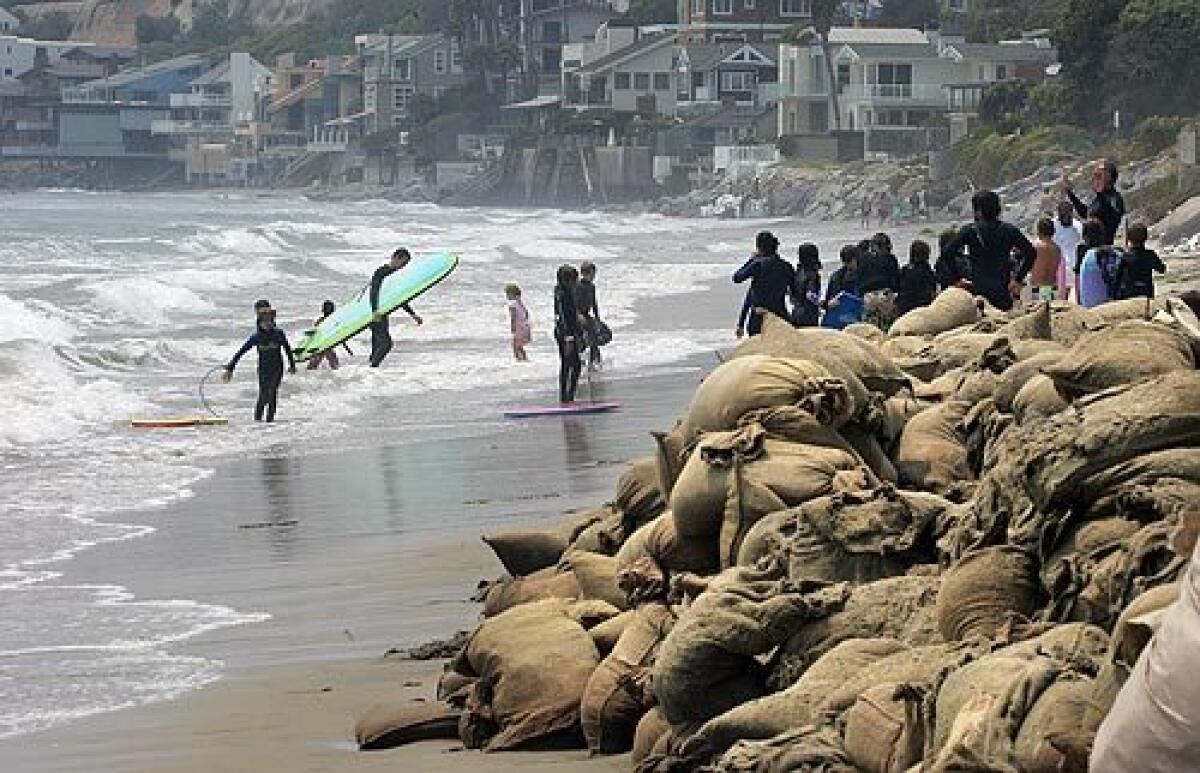Malibu’s vanishing Broad Beach a sign of rising sea levels, experts say

Broad Beach has long been a scenic backdrop to Malibu’s public access wars. The tranquil rhythm of surf has been routinely shattered by security guards and sheriff’s deputies bouncing beachgoers who spread towels on the confusing mosaic of public and private sand.
Today, Broad Beach has shrunk into a narrow sliver of its former self. And like other skinny Malibu icons, its slenderness qualified the beach for a different kind of trend-setting role: How California will deal with rising sea levels.
Sandwiched between the advancing sea and coastal armor built to protect multimillion-dollar homes, the strip of sand is being swept away by waves and tides. Soon, oceanographers and coastal engineers contend, the rising ocean will eclipse the clash between the beach-going public and the private property owners: There will be no dry sand left to fight over.
“If the latest projections of sea level rise are right, you can kiss goodbye the idea of a white sandy beach,” said Bill Patzert, a climatologist at NASA’s Jet Propulsion Laboratory in La Cañada Flintridge. “You are going to be jumping off the sea wall onto the rocks below.”
The rise of sea levels, which have swelled about eight inches in the last century, are projected to accelerate with global warming.
A group of scientists this month once again elevated those projections, suggesting that a rise of up to two feet predicted last year by the Inter-governmental Panel on Climate Change could easily double or more within the next century. The new numbers, outlined in a study commissioned by the U.S. Climate Change Science Program, take into account the latest data and observations of glacial and land ice melting, which send torrents of fresh water into the ocean.
Although scientists are likely to continue to debate how fast the ice sheets will melt, much of the projected rise results from increasing ocean temperatures. As water warms, it expands and occupies more space.
Depending on the slope of the beach, every inch of sea-level rise claims an average of 50 inches of land. That makes the long-term prospects for California’s signature beaches less than promising, as they are caught between the encroaching sea and increasingly fortified oceanfront development.
“As sea level rises, the beaches are going to get narrower and narrower,” said Robert T. Guza, a wave and coastal erosion expert at Scripps Institution of Oceanography in La Jolla. “It’s not going to be a matter of who owns the beach. It’s going to be that there will be no beach.”
Adding to the problem is a chronic shortage of beach sand, as rivers and streams have been dammed and lined with concrete to direct sediment-laden flood waters safely out to sea. These flood-control measures, as well as the building of sea walls to protect sloughing seaside cliffs and bluff-top homes, have cut off the natural flow of sand to replenish beaches.
The most sensible long-term solution, scientists say, would be for development to retreat landward and allow oceanic forces to sculpt the coastline as they have for millenniums. Waves and tides gnawing at the land would turn back-beach dunes, cliffs and hillsides into beaches of the future.
Yet that’s not likely to happen given the hefty investment in pricey homes and roads now occupying the back part of the beach. So short-term solutions get approved, often as emergency measures. Concrete sea walls and barricades of boulders get thrown up to protect such structures. Sand gets trucked in to backfill the eroded shoreline.
The problem is that imported sand gets swept away over time and the fortification of shoreline with concrete or boulders, while effective in the short term at protecting homes, often accelerates sand erosion. Sea walls act like mirrors, refracting the energy of the waves and magnifying their scouring power.
“You end up with what’s called a drowned beach,” Guza said. “At low tide, the water comes rushing up the sea wall. At high tide, there’s no beach, just water.”
Such are the forces at work at Broad Beach, which historically was in better shape than other exclusive Malibu enclaves where homes built on stilts now find these pilings standing amid swirling waters at high tide.
Broad Beach homeowners, operating under emergency permits from the city of Malibu, have shielded their property with 8- to 10-foot-high walls of sandbags, often encased in broad sheets of plastic to increase their durability. The haphazard construction has turned one of Malibu’s most beautiful beaches into something resembling a battlefield of makeshift bunkers.
“Everyone thinks of sandbags as soft protection, but these are functioning as if it was a sea wall,” said Lesley Ewing, a senior coastal engineer with the California Coastal Commission. “To the waves, they are reflecting the water like they were concrete, and the beach isn’t doing well.”
So far, the commission has stayed out of the issue, a departure from actions in 2005 when it ordered Broad Beach to remove illegal “No Trespassing” signs and restore the beach after earth movers scooped wet sand off the public beach and piled it in front of private homes.
“We are adopting a wait-and-see approach,” said Patrick Veesert, the commission’s Southern California enforcement supervisor.
Like other longtime Broad Beach visitors, Robert Ferrell, 48, of Santa Monica remains suspicious about the motives behind the sandbags.
He said he has spent years standing his ground against what he calls an “intimidation game” by private security guards and sheriff’s deputies patrolling the beach on all-terrain vehicles.
“I think they are trying to create a privacy zone,” Ferrell said. “They’re very possessive around here and don’t like the public in their backyards.”
Ken Ehrlich, an attorney representing Broad Beach homeowners, said that although no one likes the unsightly sandbags, they are merely a temporary measure to protect homes from an unprecedented pattern of erosion.
“There is no hidden agenda here,” Ehrlich said, echoing homeowners who declined to comment on the record. “The owners are trying to protect and widen the beach so these public access issues will go away.”
In recent months, the homeowners hired coastal engineers to better understand the erosion and come up with a solution that is likely to include a wall of buried boulders to fortify the beach, rock structures called groins stretching out to sea to retain sand and a regular campaign to re-nourish the emaciated beach with tons of imported sand. The cost is estimated at $10 million to $20 million and the homeowners, who include many Hollywood celebrities, are considering only private funding, Ehrlich said.
“Our hope is that at the end of this process, there is more of Broad Beach for everybody to share,” he said. “The homeowners can have their private beach and the public can have its share too.”
To scientists like JPL’s Patzert, such efforts can buy time. Still, he’s betting on the swelling sea to take ultimate control of Broad Beach.
By his calculus, catastrophe will strike when a two- to five-foot rise in sea level is joined by a 7-foot high tide and El Niño-generated storm surf of 10 feet or more.
“These folks in these overly rich communities will be sipping their martinis during some big El Niño and watching their backyards disappear in 5-feet chunks,” Patzert said. “In the end, Mother Nature and global warming will win. No matter how much concrete they pour, all of those sea walls and houses will end up in the ocean.”
More to Read
Start your day right
Sign up for Essential California for news, features and recommendations from the L.A. Times and beyond in your inbox six days a week.
You may occasionally receive promotional content from the Los Angeles Times.






